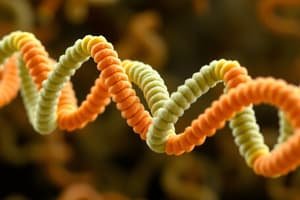Podcast
Questions and Answers
Which of the following stages of translation is responsible for the formation of a peptide bond between amino acids?
Which of the following stages of translation is responsible for the formation of a peptide bond between amino acids?
- Initiation
- Termination
- mRNA Binding
- Elongation (correct)
What is the purpose of the start codon (AUG) in the translation process?
What is the purpose of the start codon (AUG) in the translation process?
- To codes for the amino acid methionine (correct)
- To bind the large subunit of the ribosome
- To recognize the tRNA carrying methionine
- To initiate the transcription process
During the elongation stage of translation, which site on the ribosome does the tRNA carrying the growing polypeptide chain occupy?
During the elongation stage of translation, which site on the ribosome does the tRNA carrying the growing polypeptide chain occupy?
- E site
- A site (correct)
- Exit site
- P site
What is the role of the small subunit of the ribosome in the initiation stage of translation?
What is the role of the small subunit of the ribosome in the initiation stage of translation?
What is the final product of the translation process?
What is the final product of the translation process?
What is the purpose of the E site on the ribosome?
What is the purpose of the E site on the ribosome?
What is the function of aminoacyl-tRNA synthetase?
What is the function of aminoacyl-tRNA synthetase?
What is the result of the ribosome encountering a stop codon on the mRNA?
What is the result of the ribosome encountering a stop codon on the mRNA?
What is the purpose of the A site on the ribosome?
What is the purpose of the A site on the ribosome?
How many possible codons are there in the genetic code?
How many possible codons are there in the genetic code?
Flashcards are hidden until you start studying
Study Notes
Translation Process
- Translation is the process of synthesizing proteins from genetic information encoded in mRNA.
- It occurs in ribosomes, responsible for protein synthesis, and is the second step in the central dogma of molecular biology.
Initiation Stage
- mRNA binds to the small subunit of the ribosome near its 5' end at the ribosome binding site or start codon (AUG).
- The start codon (AUG) on the mRNA is recognized, coding for the amino acid methionine.
- A specific initiator tRNA carrying methionine binds to the start codon through complementary base pairing.
- The large subunit of the ribosome joins the small subunit, forming the complete ribosome and initiating translation.
Elongation Stage
- The ribosome moves along the mRNA, recognizing each codon (a sequence of three nucleotides) on the mRNA.
- Each codon is recognized by a corresponding tRNA carrying the appropriate amino acid.
- The ribosome facilitates the formation of a peptide bond between the amino acid carried by the tRNA in the P site and the amino acid carried by the tRNA in the A site.
- The growing polypeptide chain is transferred to the tRNA in the A site.
- The ribosome moves one codon down the mRNA, shifting the tRNA with the growing polypeptide chain to the P site and the now empty tRNA to the E site.
Termination Stage
- Translation continues until the ribosome encounters a stop codon (UAA, UAG, or UGA) on the mRNA.
- Stop codons do not code for any amino acids and signal the end of translation.
- Release factors bind to the ribosome at the stop codon, prompting the release of the completed polypeptide chain from the tRNA in the P site.
- The ribosomal subunits, mRNA, and release factors dissociate, freeing the newly synthesized protein.
Components of Translation
- mRNA: Carries the genetic code from DNA, specifying the sequence of amino acids in the protein.
- tRNA: Transfer RNA molecules bring the appropriate amino acids to the ribosome, with an anticodon that pairs with a specific mRNA codon.
- Ribosome: A molecular machine composed of rRNA and proteins, facilitating protein synthesis with three binding sites for tRNA: A site, P site, and E site.
- Aminoacyl-tRNA Synthetase: Enzymes that attach the correct amino acid to its corresponding tRNA.
- Initiation, Elongation, and Release Factors: Proteins that assist in the various stages of translation.
Codons
- A sequence of three nucleotides on the mRNA that corresponds to a specific amino acid or a stop signal.
- There are 64 possible codons.
Studying That Suits You
Use AI to generate personalized quizzes and flashcards to suit your learning preferences.




